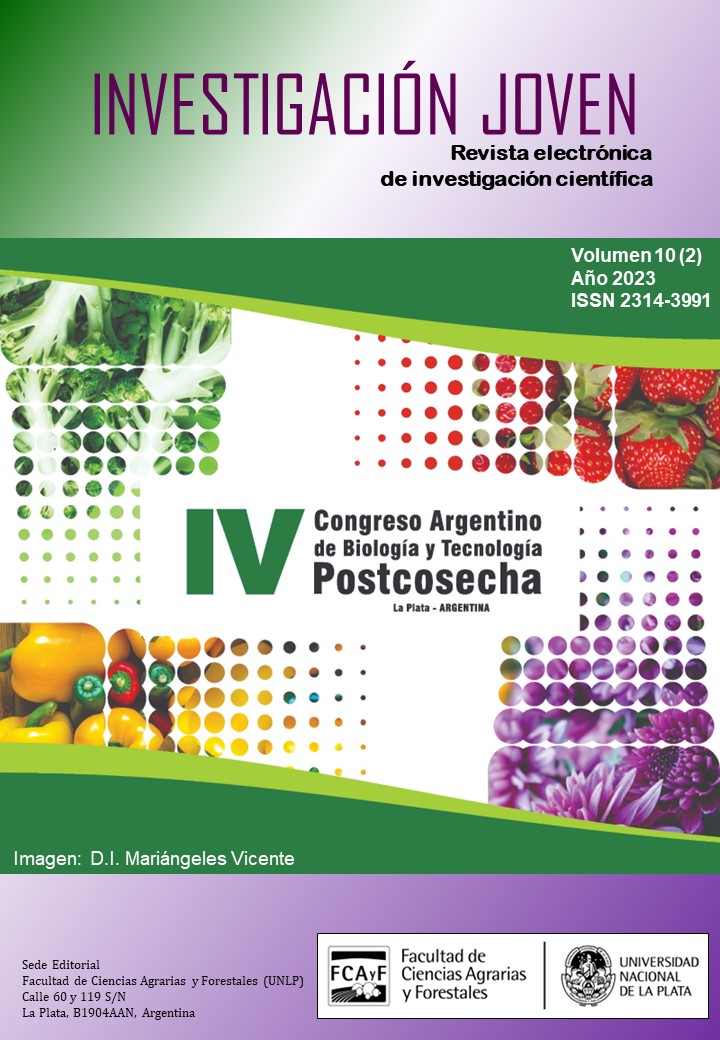Effect of 1-MCP on quality, respiratory metabolism and postharvest life Of refrigerated rocket
Keywords:
1-methylcyclopropene, leafy vegetables, dehydration, yellowing, releasing stickersAbstract
This work evaluated the effect of applying 1-methylcyclopropene (1-MCP) via release stickers on refrigerated rocket bundles. Forty rocket leaf bundles were washed and disinfected with NaOCl (100 ppm, pH 6.5, 10 min). Then, they were placed in bags with or without stickers (Vidre+®). After 0, 5, 12, and 17 days at 5 ºC, the following were analyzed: appearance, deterioration index, pigments, color, weight loss, respiratory rate, soluble solids, pH, antioxidants against ABTS•+, and phenols. The 1-MCP clearly maintained better visual quality. Although green color retention was observed with 1-MCP, it did not differ in pigments compared to the control. On the other hand, 1-MCP exhibited a lower respiratory rate at 5 and 17 days, showing less weight loss than the control at the end of the assay. Weight loss was mainly associated with water loss through respiration. 1-MCP did not affect nutritional quality but influenced respiratory metabolism (CO2 release and water loss). Applying 1-MCP stickers in rocket leaves could be considered for individual packages and drawers covered with film or IV Gamma products.
Downloads
References
J. Barillardi, D. Canistro, M. Paolini, F. Ferroni, G.F. Pedulli, R. Iori, L. Valgimigli. “Direct antioxidant activity of purified glucoerucin, the dietary secondary metabolite contained in rocket (Eruca sativa Mill) seeds and sprouts”. Journal of Agricultural and Food Chemistry 53, 2005, 2475‐2482.
C. Moreno, M.J. Andrade-Cuvi, M.J. Zaro, M. Darré, A.R. Vicente, A. Concellón. “Short UV-C treatment prevents browning and extends the shelf-Life of fresh-Cut carambola”. Journal of Food Quality, 2017 9 pp.
C.Y. Wang. “Postharvest techniques for reducing low temperature injury in chilling-sensitive commodities”. En Improving postharvest technologies of fruits, vegetables and ornamentals. F. Artés, M.I. Gil, M.A. Conesa (Eds). International institute of refrigeration. Murcia (España). 2, 2000, 467-471.
R. Fluhr. “Ethylene perception: from two-component signal transducers to gene induction”. Trends in Plant Science. 3, 1998, 141–146.
S.D. Yoo, Y. Cho, J. Sheen. “Emerging connections in the ethylene signaling network”. Trends in Plant Science. 14, 2009, 270–279.
S. Lurie, G. Paliyath. “Enhancing postharvest shelf life and quality in horticultural commodities using 1-MCP technology”. En: G.D. Paliyath, A. Murr, A. Handa y S. Lurie, Postharvest Biology and Technology of fruits, vegetables, and flowers. Ed: Wiley-Blackwell Publishing, New Delhi, India, 2008, 162pp.
J.F. Massolo, A. Concellón, A.R. Chaves, A.R. Vicente. “1-Methylcyclopropene (1-MCP) delays senescence, maintains quality and reduces browning of non-climacteric eggplant (Solanum melongena L.) fruit”. Postharvest Biology and Technology. 59, 2011, 10-15.
J.F. Massolo, A. Concellón, A.R. Chaves, A.R. Vicente. “Use of 1-methylcyclopropene to complement refrigeration and ameliorate chilling injury symptoms in summer squash”. CyTA - Journal of Food. 11, 2013, 19-26.
T.K. Satekge, L.S Magwaza. “Postharvest application of 1-methylcyclopropene (1-MCP) on climacteric fruits: factors affecting efficacy”. International Journal of Fruit Science. 22, 2022, 595-607.
L. Li, A. Lichter, D. Chalupowicz, D. Gamrasni, T. Goldberg, O. Nerya, R. Ben-Arie, R. Porat. “Effects of the ethylene-action inhibitor 1-methylcyclopropene on postharvest quality of non-climacteric fruit crops”. Postharvest Biology and Technology. 111, 2016, 322–329.
J.F. Massolo, L. González Forte, A. Concellón, S.Z. Viña, A.R. Vicente. “Effects of ethylene and 1-MCP on quality maintenance of fresh cut celery”. Postharvest Biology and Technology. 148, 2019, 176–183.
A.S. Siomos, A. Koukounaras y E. Sfakiotakis. (2006). “1-Methylcyclopropene prevents ethylene induced yellowing of rocket leaves”. Postharvest Biology and Technology, 41, 2006, 109–111.
R.G. McGuire. “Reporting of objective color measurements”. Horticultural Science. 27, 1992, 1254-1255.
H.K. Lichtenthaler. “Chlorophylls and carotenoids: pigments of photosynthetic biomembranes”. Methods in Enzymology. 148, 1987, 350–382.
M.B. Arnao, A. Cano, M. Acosta. “The hydrophilic and lipophilic contribution to total antioxidant activity”. Food Chemistry. 73, 239–244.
V. Singleton, R. Orthofer, y R. Lamuela-Raventos. “Analysis of total phenols and others oxidation substrates and oxidants by means of Folin-Ciocalteau reagent”. Methods in Enzymology. 299, 1999, 152-178.
P. Matile, S. Hörtesnsteiner, H. Thomas. “Chlorophyll degradation”. Annual Review in Plant Physiology and Plant Molecular Biology. 50, 1999, 67-95.
A.E. Watada, K. Abe, N. Yamuchi. Physiological activities of partially processed fruits and vegetables. Food Technol 1990, 116–22.
B. Sun, H. Yan, N. Liu, J. Wei, Q. Wang. “Effect of 1-MCP treatment on postharvest quality characters, antioxidants and glucosinolates of Chinese kale”. Food Chemistry, 131, 2012, 519-526.
V.H. Escalona. “Uso de envasado en atmósfera modificada en los productos de IV y V gama”. Agrociencia (Uruguay), 21, 2017, 1-6.
J. Mainardi, E. Purgatto, A. Jr. Vieira, W.A. Bastos, B.E. Cordenunsi, J.R. Oliveira, F.M. Lajolo. “Effects of ethylene and 1-methylcyclopropene (1- MCP) on gene expression and activity profile of a-1,4-glucan-phosphorylase during banana ripening”. Journal of Agricultural and Food Chemistry. 54, 2006, 7294-7299.
Downloads
Published
How to Cite
Issue
Section
License
Copyright (c) 2023 María Raquel Taus, Joaquín Héctor Hasperué, Luis María Rodoni, Juan Facundo Massolo

This work is licensed under a Creative Commons Attribution-NonCommercial-ShareAlike 4.0 International License.
















